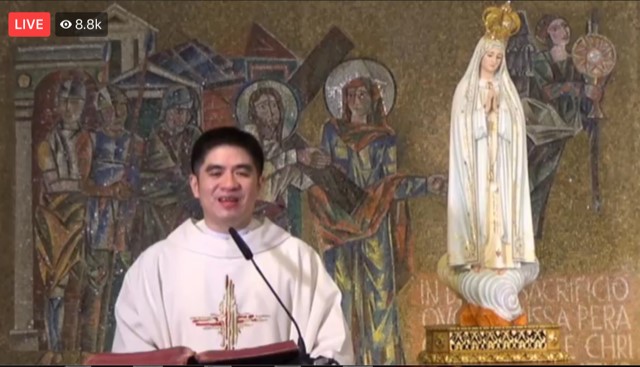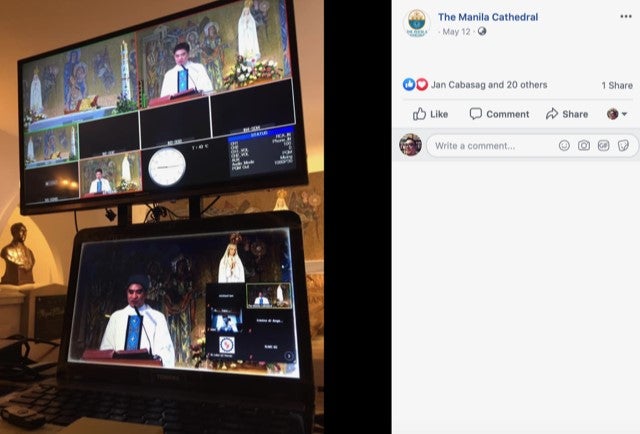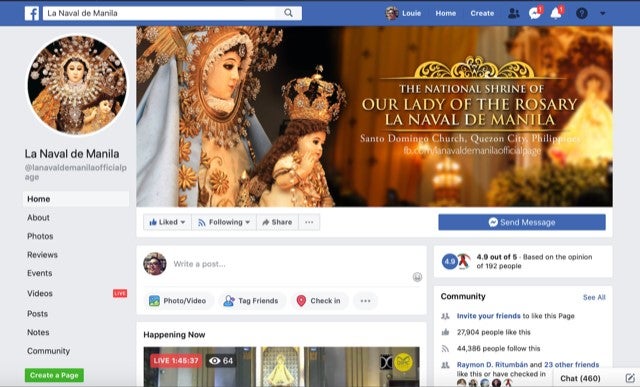Catholic Liturgical Televisuality in the Time of Pandemic
contributed by Louie Jon A. Sánchez, 04 June 2020
On the Catholic Church’s commemoration of World Communication Sunday last May 24, 2020, the Philippines marked day 69 of the state’s enhanced community quarantine (the strictest form of quarantine enforced in high risk places), which started on March 15. Expected to end by May 30, it is said to be longer than the lockdown enforced in Wuhan, China, once the ground zero of the Covid-19 pandemic. It may as well be the longest time in living memory that Filipino Catholics have not attended masses and devotions in churches.
Physical distancing however has not prevented the Philippine Catholic Church in its apostolate. As the country braced for the pandemic, the Church fully turned to social media, and “liturgical televisuality,” to respond to the faithful’s much needed spiritual nourishment. By far, liturgical televisuality through social media has fostered community spirit, inspired financial support to various Church ministries and triggered aid and relief responses to the pandemic.
Liturgical Televisuality in the Philippines
Masses and rituals on television are not entirely a new phenomena in the Philippines, a predominantly Catholic country. “Sunday TV Masses” are aired by at least 3 networks, most notably, TV network ABS-CBN’s The Healing Eucharist. On the other hand, the Church itself manages TV Maria, the only Catholic TV station in the country, airing masses and religious shows in a very limited capacity. Its counterpart Veritas 846, “the number one faith-based radio station in the country,” enjoys a strong following nationwide.

Figure 1: Healing Eucharist YT: Filipino TV Network ABS-CBN's "The Healing Eucharist," perhaps the most popular televised Sunday mass in the country, also airs in Youtube (screen grab by the author)
Holy Week rituals from Holy Wednesday until Easter Sunday are also aired on TV, even as the broadcast industry takes a break during the season. This was until this pandemic overran the entire Lenten season this year and moved all rituals online. Meanwhile, every January, the biggest street procession in Manila celebrating the Feast of the Black Nazarene, dating back to the Spanish colonial period, is covered by TV news by the hour.
Liturgical televisuality has long been a norm, serving the sick and the infirm, and even Filipinos in the diaspora. It bolsters the Church’s social communications, occasionally supported by commercial TV. However, the Church in the past years has been tapping into social media, Facebook (FB) and Youtube in particular, to expand liturgical televisuality. After all, the internet has become a televisual screen extension.
Before Covid-19, three popular Catholic shrines in the capital Metro Manila—the Black Nazarene’s Quiapo Shrine, the Redemptorist Shrine of the Mother of Perpetual Help in Baclaran, and the Shrine of St. Jude Thaddeus—have been broadcasting liturgies through FB, which became in recent times more useful given the monstrous metropolitan traffic.
Other churches followed suit, propagating devotion to saints and other icons, using the most basic of resources like smartphone cameras or the most advanced broadcast equipment. Religious orders and groups followed this established pattern once the quarantine began.
Collectively, all these became platforms for orienting Catholics on the safety precautions required during the crisis, as well as popularizing the Church-issued oratio imperata [“obligatory prayers” in grave need or calamities] against the disease. This was earlier recited in masses when churches were yet to be closed down.

Figure 2: Oratio Imperata: ABS-CBN News circulating the Oratio Imperata on Facebook (screen grab by the author)
Covid-19 Liturgical Televisualities: Three Cases
The Manila Cathedral
Covid-19 has made liturgical televisuality a necessity as more and more parishes wished to keep tending to their flocks even by remote means. And to sustaining faith in a time of pandemic, online church broadcasters offered catechesis, talk shows, musical concerts, and other inspirational content.
The Manila Cathedral, seat of the Archdiocese of Manila, offers the most polished liturgical televisuality on FB. Aside from daily and Sunday masses, all streamed in pristine quality from the cathedral’s crypt chapel, with a magnificent wall mosaic depicting the Passion of Christ in the background, the Cathedral also features videos on praying the rosary, and most recently, a primer on protocols for the reopening of churches. Once, it even celebrated mass with groups of medical frontline workers hooked up via Zoom.
For more than two months now, the Cathedral has been true to its pledge: “to make sure that the Liturgy is celebrated in a dignified and noble way, as our beautiful worship of God.” On World Communication Sunday, its 8 am Mass yielded close to 40 thousand views. The church FB page has grown to more than 400 thousand followers.

Image 3: Manila Cathedral Team: In this post, the Manila Cathedral broadcast team, led by Fathers Reginald Malicdem (center) and Kali Pietre Llamado (first row, third from the left), thanks supporters (screen grab by the author)

Image 4: Manila Cathedral BTS: The Manila Cathedral posts a "BTS" [behind the scenes] (screen grab by the author)

Image 5: Manila Cathedral-FB Front Page: The Manila Cathedral Facebook Page, with its header featuring Apostolic Administrator Bishop Rhoderick Pabillo (center) with the mayors of five Metro Manila cities under the jurisdiction of the Archdiocese of Manila. Last May 13, these government officials gathered at the Cathedral for a national day of prayer and consecration to the Immaculate Heart of Mary (screen grab by the author)
Santo Domingo Church
Another notable Metro Manila church engaged in extensive FB broadcasting is the Dominican Santo Domingo Church, home to the miraculous Our Lady of the Holy Rosary of La Naval. The image of La Naval is centuries old and quite fabled—its intercession is believed to have brought victory to Spanish and Filipino forces against the Dutch fleet in 1646.
The Dominicans of Santo Domingo have been known for TV broadcasts of Holy Week rituals. In this time of pandemic, they streamed daily masses, recited the Holy Rosary, and exposed the Blessed Sacrament in the side altar where the regal La Naval virgin is enthroned. Their broadcast also featured a nightly exorcism rite to “stem the scourge of the pandemic,” framing the health crisis as spiritual warfare. The rite attracts a regular following, one among many nationwide, though reports of demonic retaliations later on compelled the Archdiocese of Manila Office of Exorcism to tone down the prayers used.
Meanwhile, the church’s most moving televisual spectacle is the “dungaw” [literally, in Filipino, “to look out,” of windows or doors perhaps], when Dominican friars open the church front doors every morning to expose a replica of La Naval to the world. It’s as if the virgin also looks out in compassion. The parish FB page has roughly 45 thousand followers.

Figure 6: Sto. Domingo-Dungaw: The most moving part of Santo Domingo Church's daily Facebook broadcast is the "dungaw," when the replica of the Virgin of La Naval is exposed to the world, as the church front doors are being opened (screen grab by the author)

Figure 7: Sto. Domingo-FB Front Page: The Sto. Domingo Church Facebook Page, prominently featuring its fabled patron, Our Lady of the Most Holy Rosary of La Naval (screen grab by the author)
The Jesuit Outreach
Meanwhile, the Jesuits, whose home base is Ateneo de Manila University, have also been investing in social media broadcasting for quite a while, aside from occasional forays in commercial broadcasting. The Jesuits use the university’s online Radyo Katipunan to stream “Daily Mass for Difficult Times,” as well as other programs that enrich the Catholic faith and stir socio-political engagement.
In Youtube, the order’s Jesuit Communications TV inspires by way of Gospel songs popularized in the country by the Jesuits, as well as down-to-earth scriptural reflections. The site’s series Kape’t Pandasal is very notable for its mass appeal. Kape’t Pandasal is a wordplay on the Filipino expression “Kape’t Pandesal,” meaning “Coffee and Breakfast Bread,” with “Pandesal” being respelled “Pandasal,” meaning “prayer” and also alluding to Christ being the “bread of life”; the title may then be translated as “Prayer that Perks Up”. Another show, The Word Exposed, still airs on the platform, despite the host Filipino Cardinal Luis Antonio Tagle’s recent appointment as Vatican prefect of the congregation for the evangelization of peoples. Tagle’s Gospel reflections are well-followed locally and internationally, given his prominence and charisma.

Image 8: Kape't Pandasal-FB Front Page: The "Kape't Pandasal" Facebook Page celebrating the 15th year of the program. The header features the show's hosts, led by (center) Luis Antonio Cardinal Tagle, the Vatican prefect of the congregation for the evangelization of peoples (screen grab by the author)
Liturgical Televisuality as Frame
Liturgical televisuality, in the time of Covid-19, has become the sustaining frame by which the Philippine Church continues to pursue a narrative of encounter, despite physical distancing. Certainly, it is, in the words of Pope Paul VI’s 1963 social communications decree Inter Mirifica, “among the wonderful technological discoveries” that needs to be harnessed and “properly utilized...(to be) of great service to mankind” today.
Catholic leader Pope Francis himself had set an example for its use during his special and unforgettable urbi et orbi [“To the City of Rome and the World” apostolic address and blessing, usually given only on Christmas Day and Easter] last March 27, as many were being afflicted by the pandemic in Italy. He also celebrated masses streamed around the world until the Vatican reopened last March 18.
In his May 24 World Communications Day address, the pope emphasized the importance of storytelling, founded on encounter, as this does not only “make our own the truth contained in good stories,” but also enables us “to speak of ourselves and of the beauty all around us,” amidst “the cacophony of voices and messages that surround us.”
In the days to come, liturgical televisuality in the Philippines certainly will grow and expand, going beyond masses and rituals, and perhaps fully establishing itself in a sustainable way, using the Church’s selected forms of storytelling. Hopefully, it will also help the Church weave televisual narratives “that can regard our world and its happenings with a tender gaze...that can tell us that we are part of a living and interconnected tapestry...(and) that can reveal the interweaving of the threads which connect us to one another,” as Pope Francis himself puts it.
Louie Jon A. Sánchez is assistant professor of English at the School of Humanities, Ateneo de Manila University in the Philippines. He teaches writing, literature, popular culture, and television studies. He is associate editor of Suvannabhumi, a multidisciplinary journal of Southeast Asian Studies, Korea Institute of ASEAN Studies, Busan University of Foreign Studies.
Disclaimer: The views and opinions expressed in this article are those of the authors and do not necessarily reflect the position of the blog editorial team or the Asia Research Institute.
South Asia | Southeast Asia | East Asia | Other Places | Hinduism | Buddhism | Islam | Christianity | Other Religions

